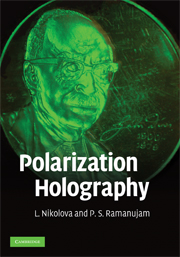Book contents
- Frontmatter
- Contents
- Preface
- List of symbols and abbreviations
- 1 Light polarization
- 2 Light propagation through polarizing systems
- 3 Theory of polarization holography
- 4 Azobenzene and azobenzene-containing polymers
- 5 Other photoanisotropic materials
- 6 Applications of polarization holography
- 7 Conclusions and future prospects
- Index
- Plate section
Preface
Published online by Cambridge University Press: 07 August 2009
- Frontmatter
- Contents
- Preface
- List of symbols and abbreviations
- 1 Light polarization
- 2 Light propagation through polarizing systems
- 3 Theory of polarization holography
- 4 Azobenzene and azobenzene-containing polymers
- 5 Other photoanisotropic materials
- 6 Applications of polarization holography
- 7 Conclusions and future prospects
- Index
- Plate section
Summary
In contrast to the conventional holographic process, in which intensity variations in an interference pattern between an object beam and a reference beam are recorded, polarization holography employs beams with two different polarizations for recording information. In this case, the polarization state of the resultant beam is recorded on a suitable medium. This process was discovered by Sh. D. Kakicheshvili, from Georgia (which was then part of the USSR). Currently there is only one monograph on polarization holography, namely that written in Russian by Kakicheshvili (Polyarizatsionnaya golografiya, Nauka, 1989). However, because of its complex presentation, this monograph is not easily amenable for application to practical work.
Polarization holographic storage has several unique properties: (1) it is possible to achieve theoretically 100% diffraction efficiency even in thin films; (2) the diffracted beams have unique polarization properties, depending on the polarization of the recording and read-out beams; (3) it is possible to fabricate polarization-sensitive optical elements; and (4) the optical elements fabricated with polarization holography are achromatic, allowing their use at all wavelengths.
Our book intends to fill a gap in the area of holography, and documents research done during the last two decades. High-capacity holographic storage remains a hot topic. This book is intended for scientists as well as students at graduate and postgraduate level. A basic undergraduate optics background is assumed, and a well-prepared undergraduate physics major will be able to appreciate the subtleties of polarization holography.
Information
- Type
- Chapter
- Information
- Polarization Holography , pp. ix - xiiPublisher: Cambridge University PressPrint publication year: 2009
